-
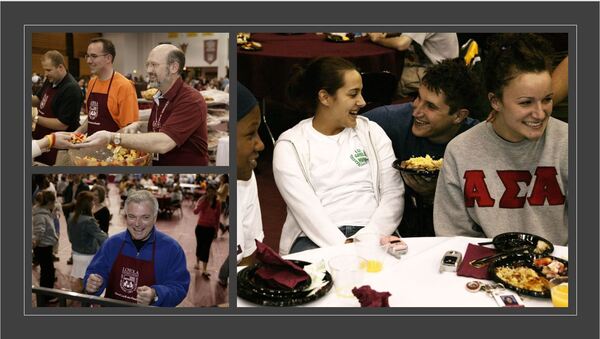
A collage features color pictures of the annual Finals Breakfast at Loyola. Father Michael J. Garanzini, S.J. is seen serving alongside faculty, and there is a photo of students enjoying the event.
-
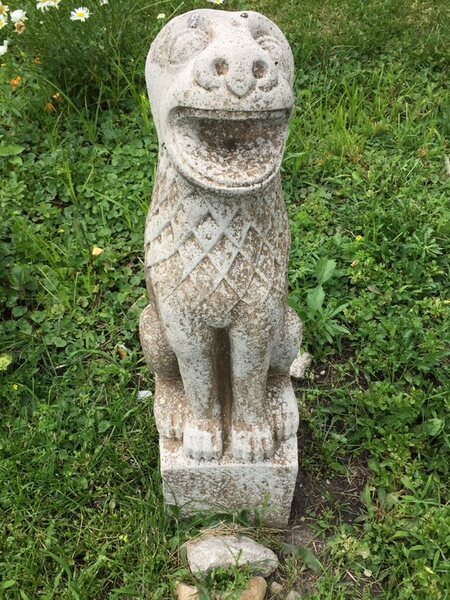
Color photo of a small statue in the Medieval garden near Crown Center on the Lake Shore Campus.
-
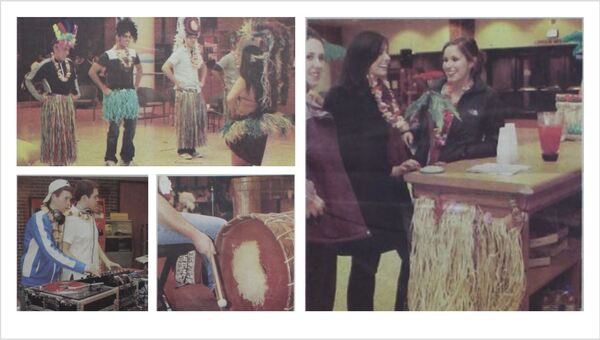
Color photos from the Loyola Phoenix of a student event called the Late Night Luau.
-
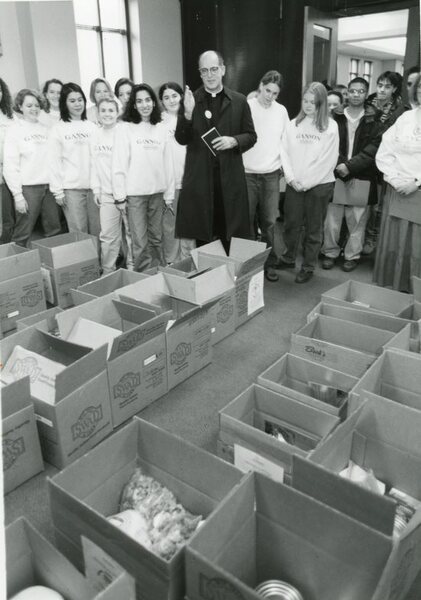
Black and white photo of Father James Piderit S.J. blessing the food before it is delivered to families for Thanksgiving.
-
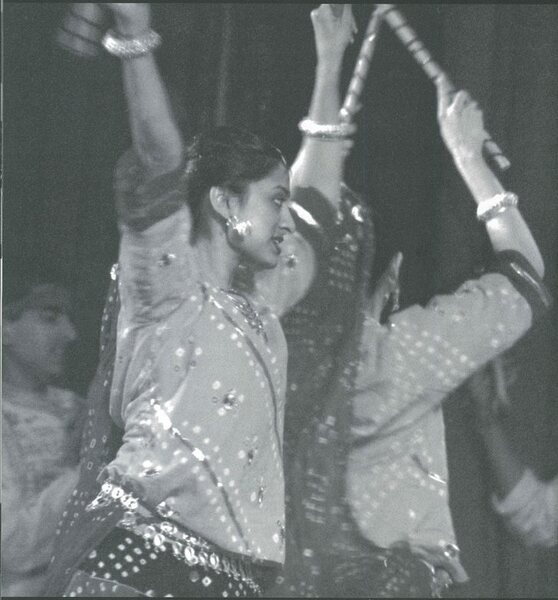
Black and white photograph of students dancing at Unity in Diversity month
-

Color photo of a student run fundraiser for Red Cross immediately following 9/11/
-
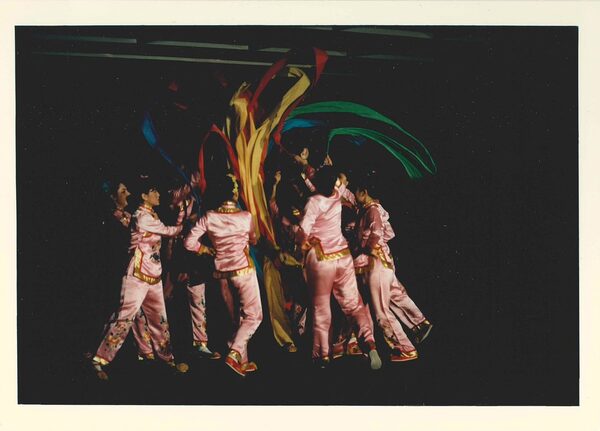
Color photograph of International Night: an annual performance night on campus
-

The front cover of the "Kleenex" : the annual April Fool's edition of the Loyola Phoenix - 2009
-
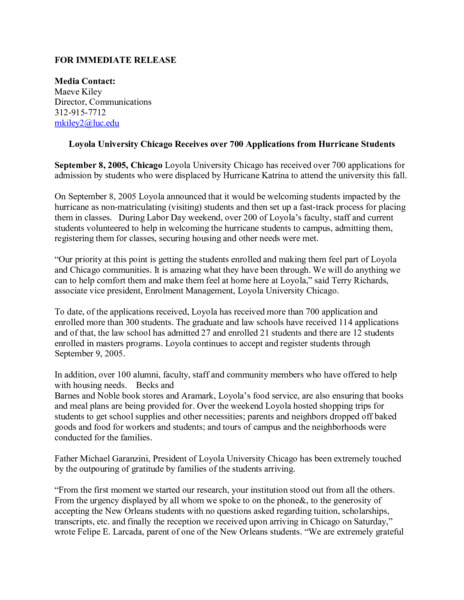
Press release concerning LUC temporarily taking in students from Loyola University New Orleans, Tulane, Xavier University, Dillard, and University of New Orleans after Hurricane Katrina
-
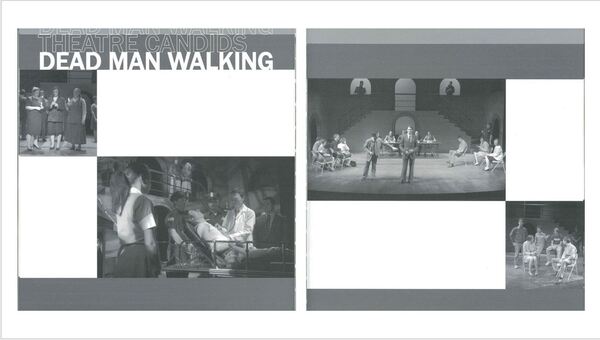
Yearbook pages displaying pictures of the the "Dead Man Walking" production done at LUC. It was a theatre campaign run at universities across the country to get students talking about the death penalty.
-

The cover of the Loyola Magazine after September 11, 2001. Picture of a firefighter's hat. Issue concerned alumni working in first response fields.
-

An article by "Zoowap Mmmbop" in the April 1, 2009 edition of The Kleenex, "the unofficial jokester pape[r] of Loyola University Chicago," published annually on April Fool's Day.
The satirical article claims that "In an effort to increase funding and maintain its literary panache, Cudahy Library is restricting all student access to its popular quiet study room and will begin offering daily tours to tourists effective Monday, according to Loyola library directors."
A photo features a cute child in a purple costume, with the caption: "I am the cute one -- The cutest kid ever tours the library."
The article continues, saying that the study room now boasts "a photo booth, souvenir shop and Dippin' Dots ice cream cart for wanting tourists."
"'The current economic crisis is no joke to us; we needed to reconsider our target audience,' said John Middleberry, Ph. D., director of Cudahy Library, as he checked admission tickets and reminded tour-goers to check out the clearance rack at the souvenir shop.
'The days were numbered for those good for nothin' freeloading kids, with their Kindle 2s and BookFace, it was time to take a stand against them,' said Middleberry."
The article goes on to include a surprised reaction from an English major and a classical studies major's threat to proclaim an "all-out takeover of the study space."
-

An article by Joanna Manieri and Monica Patankar covers the Loyola Model United Nations team's upcoming trip to New York to represent Loyola at the National Model U.N. Conference in New York.
The team planned to travel with a delegation from the Japan Model U.N. program, who had arrived at Loyola on April 1 in order to "become acquainted with and compare research with members of Loyola's" team. The two groups would team up to represent Brazil at the upcoming conference. "Most students are paired with a Japanese student; however, some Loyola students in smaller committees will work on their own, according to [Magdalena] Walczak," graduate assistant for the Loyola team.
The Japanese students were chosen from Japan's universities to compete around the world, and had specifically chosen Loyola for several reasons, including their high rankings the previous year.
While practicing, students recognized that every committee would "inevitably go back to the current war in Iraq," whether from a human rights, economic, or environmental standpoint.
Item 1: Whole article
Item 2: Photograph depicting the Model U.N. team members gathered in Galvin Auditorium "to discuss and vote on issues concerning international drug trafficking laws. The meeting is a simulation designed to replicate deliberations of the real U.N. resolution for drug trafficking."
-

A full-page article recaps the annual All-Niter event held the weekend before.
The article features top and bottom banners from the game Pac-Man, along with more Pac-Man details in the center.
The top reads:
"All-Niter features '80s revival
Balloons and bingo, bands and a bull - it all happened at the '80s-themed All-Niter, an annual C.L.U.B. sponsored, Centennial Forum Student Union party that went down late last Friday until sun-up Saturday, coinciding with Little Siblings Weekend. Below are some of the festive photos from the night that never ended."
Photos include:
Freshman Andy Davis plays keyboard in the talent show.
Siblings and students joke around with a clown.
Freshmen dance for the camera.
A Loyola student rides the All-Niter's treacherous mechanical bull.
One of Mertz's infamous false fire alarms leaves a little sib shivering.
The student band John Adams 4 fights for first place at the Battle of the Bands.
-

An article by Darcia Jinkersen, with photos by Zayil Cuaya, reports on the annual Tunnel of Oppression event, which took place the week before for the sixth year in a row. Tunnel of Oppression aimed "to educate students about the issues minorities face." The show presented a "multi-sensory experience to engage the students' emotions" and drew about 450 attendees, more than double the previous year's attendance. The event was planned by the Department of Residence Life along with The Anti-Racism Movement (A.R.M.), Black Culture Center, and Advocate (the LGBTQA association).
Three 25-minute-long skits reenacted racism, sexism, and heterosexism (homophobia) in students' daily lives. "In these scenes, members of different minority groups are questioned about their schoolwork, their relationships and other issues directly related to student life."
"'As we were showing the skits, some people were shocked, some dropped their jaws, some were nodding their heads in realization,' said Kashan Malik, a fifth-year student who acted in one of the skits and is a member of A.R.M.
The presentation stressed that discrimination is present even at Loyola."
"A lot of the examples I've definitely seen firsthand," said sophomore Amy Tournox, who attended the show.
Loyola Students for Life "provided a PowerPoint presentation against the death penalty, using pictures to humanize death row inmates and encouraging students to sympathize with the prisoners.
After the presentation, a mediated discussion challenged students to confront their ideas about discrimination and how it is displayed in their daily lives."
Sophomore Ali Ahmed said, "Even during the discussion I saw people who were uneasy... I think the interesting part is seeing people talk about race and think, 'Oh my God, is that present?'"
"The idea for the Tunnel of Oppression originated from a program at Western Illinois University.
'It's been adapted,' said Jana Lithgow, the resident director for Regis and Creighton, who helped plan the event. 'It gives our program a chance to collaborate with other groups to educate students about oppression, both at our institution and globally.'
'I hope at Loyola people will open their eyes,' said junior Brittany James, an actress in the event.
The Tunnel of Oppression is also a part of LGBTQA Awareness Month. The departments of University Ministry, student diversity and multicultural affairs and fine arts also supported the cause."
Image 1: whole article
Image 2: detail of photo featuring a skit demonstrating discrimination that homosexual community members face
-

A two-page article with several photos of students and supporters protesting on campus, written by LeeAnn Maton and photos by Tim Bloomquist and Nick Befort.
"Prompted by a Labor Day weekend incident in which a campus safety officer allegedly racially profiled a group of minority students, A.R.M. [Loyola's Anti-Racism Movement] is 'a concerned group of students who are taking action against the systemic discrimination of students at Loyola,' according to a latter from A.R.M.'s executive board sent to the Phoenix."
A.R.M. organized a march at the Lake Shore campus, attended by hundreds of students, faculty, and staff members. Chants included "We pay for education, not discrimination" and "What do we want? Change! When do we want it? Now!"
The march began with petition-signing and several speeches. Then, "the mass of people wound down Campus Road and Sheridan Road to the Sullivan Center in order to deliver a letter of protest to the office of Rev. Michael J. Garanzini, S.J., the university president." Though he was out of state that day, demonstrators tied a green armband to the door handle and slid the letter under the door.
The letter laid out eight requests, including "a set procedure for students and faculty to file cases of discrimination in such a way that the victims do not face repercussions." Other requests included "a student oversight board to work with Loyola administrators," "a faculty-student summit to draft a proposal to increase minorities in tenure track positions," and "apologize to the students involved in the Labor Day incident." Copies of the letter were also delivered to the campus safety office, the office of student affairs and the office of student diversity.
Freshman demonstrator Michelle Cruz said "You didn't see yourself as an individual. Yous aw the power of community, especially with the chants." She decided to join A.R.M after attending Monday's kickoff rally, where she saw how diverse the group was.
Director of Student Diversity Kevin Huie and Lt. Robert Fine from the department of campus safety saw the protest as peaceful and organized. A.R.M. founding member freshman Erica Granados-De La Rosa said the event was powerful, with the crows "energized, passionate, ready."
"'The atmosphere there felt emotionally overwhelming,' freshman demonstrator Olga Konyakova said in an e-mail interview, 'especially when Erica [Granados-De La Rosa] and another girl began singing the civil rights song, 'We Shall Overcome.' For a moment, I thought I could feel the passion of those people who were fighting for civil rights in the past.'"
Garanzini received the letter despite being out of town and responded by email with an apology. He met with A.R.M. and the Granados-De La Rosa felt it was "productive" and that tensions had started to clear to make way for solutions.
Outside media coverage angered many Loyolans, according to the article. A CBS 2 News story cited a segment of a university press release denying the racial profiling incident.
Granados-De La Rosa felt the movement was headed toward creating "mutual respect" between students and administrators.
-

This photo by Nick Kocmich appears in an article by Dianna Heitz that addresses responses to a bulletin board created by R.A.s in Mertz Hall. The three R.A.s (resident assistants) created it "in an attempt to promote a better understanding of inequalities and injustices pertaining to race relations" and posted it on the second floor of Mertz Hall near the elevators. The messages on the board were based on an article titled "White Privilege and Male Privilege: A Personal Account of Coming to See Correspondences Through Work in Women's Studies" by former Loyola Women's Studies professor Peggy McIntosh.
According to the article, the bulletin board (which features in the photograph) "displayed numerous white privileges described in McIntosh's article, a definition of white privilege and instances in the media of white privilege. For example, the differences in the portrayal of black and white women in film were shown using the moves 'The First Wives Club' and 'Waiting to Exhale.'
In the article, McIntosh defines white privilege as 'an invisible package of unearned assets that [Caucasians] can count on cashing in each day, like special provisions, assurances, tools, map guides, code books, and blank checks.'
McIntosh says 'white privilege' gives certain unfair privileges to white individuals over minorities."
"Many Mertz Hall residents, however, said they were confused with the board's message and purpose. The board's topic also sparked a controversy among students.
A forum took place Feb. 11 in Mertz Hall's West Lounge to discuss the controversy, according to one R.A." to discuss positive and negative reactions to the board and clarify its purpose.
A program coordinator for the department of student development and diversity, as well as sociology professor Emily Ignacio, attended to facilitate an open discussion on race relations and the implications of the board.
"Roughly 40 people of different ethnicities attended the forum and filled West Lounge for the 90-minute discussion.
"Many students simply wanted to know why the board was put up during Black History Month.
Some students came to the forum in search of a better understanding of what they consider to be the definition of white privilege."
"Many African American students told stories of what it felt like to experience racism firsthand. Some students said they had witnessed white privilege, while others felt they had been given privileges because of their skin color." Others doubted that the sign would have any impact.
Ignacio urged participants to continue this type of open dialogue.
-
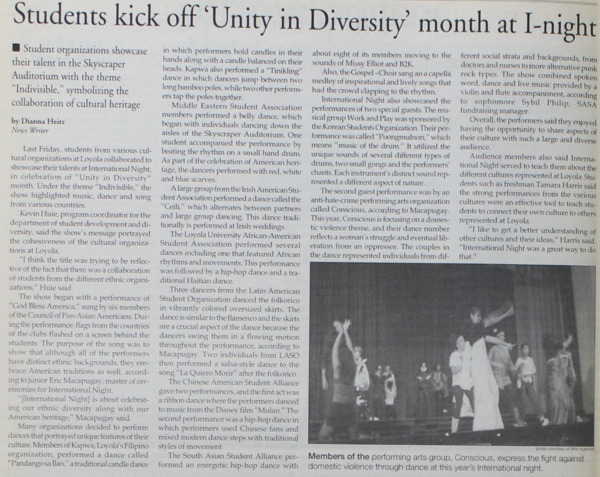
An article reports on the International Night performance held by a number of student organizations to kick off Unity in Diversity month at Loyola. The theme was "Indivisible," highlighting music, dance, and song from various countries.
According to junior Eric Macapugay, who was the master of ceremonies, "[International Night] is about celebrating our ethnic diversity along with our American heritage."
The show began with six members of the Council of Pan-Asian Americans singing "God Bless America." Members of Kapwa, Loyola's Filipino organization, performed "Pandango sa llao," a traditional candle dance in which performers hold candles in their hands along with a candle balanced on their heads, and a "tinikling" dance in which dancers jump between two long bamboo poles, while two other performers tap the poles together.
Middle Eastern Student Association members performed a belly dance with red, white, and blue scarves to celebrate American heritage.
A large group from the Irish American Student Association performed the "Ceili," which alternates between partner and large group dancing and is traditionally performed at weddings.
The Loyola University African-American Student Association performed several dances, including more traditional African and Haitian dances and hip hop.
Three dancers from the Latin American Student Organization (LASO) performed the folklorico in vibrantly colored skirts, and two of them performed a salsa-style dance.
The Chinese American Student Alliance gave two performances: first, a ribbon dance set to music from Disney's Mulan. Second, a hip-hop dance using Chinese fans and a mix of traditional and modern styles of movement.
The South Asian Student Alliance performed a hip-hop dance set to Missy Elliot and B2K.
The Gospel-Choir sand an a capella medley of inspirational and lively songs that had the crowd clapping to the rhythm.
Two guests also performed. First, the Korean Students Organization sponsored Work and Play, who performed "Poongmulnori," or "music of the drum." Second, the anti-hate-crime performing arts organization Conscious performed a number pictured here to reflect a woman's struggle and eventual liberation from an oppressor.
Student performers said they enjoyed the opportunity to share parts of their culture with such a large and diverse audience. Likewise, audience members learned about the diversity of cultures represented at Loyola.
-
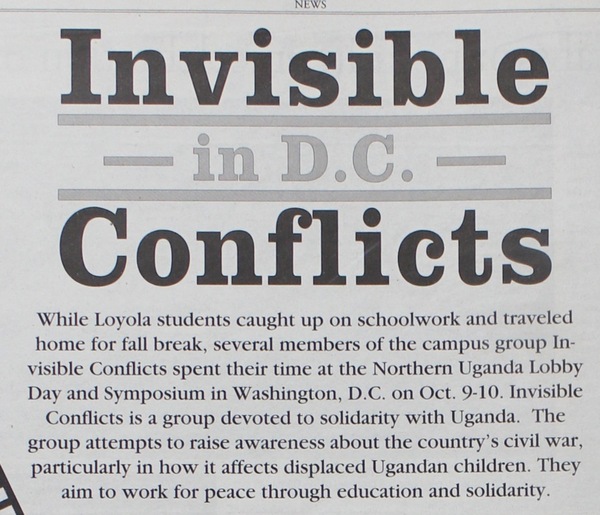
The title and first paragraph of a large article by William Barrett reports on the Loyola student organization Invisible Conflicts. Invisible Conflicts "is a group devoted to solidarity with Uganda. The group attempts to raise awareness about the country's civil war, particularly how it affects displaced Ugandan children. They aim to work for peace through education and solidarity." Members of the group went to the Northern Uganda Lobby Day and Symposium in Washington D.C. on October 9-10, 2006.
These students payed from their own pockets to travel to George Washington University to prepare for lobbying Congressmen "to craft a resolution for the two million people victimized by the two-decade long struggle in eastern Africa." The U.S. had not taken an official position on peace talks. Invisible Conflicts also felt it was important to hold leaders of African countries accountable for financial assistance being sent to them.
Many other organizations took part in the lobbying day. The students interviewed felt optimistic about the reception they received and felt that representatives such as Jan Schakowsky were ready to listen. They also listened to speakers and felt they gained a sense of the wide range of perspectives within the United States. Students stayed in youth hostels with other young lobby participants.
Invisible Conflicts planned screenings of the documentary "Invisible Children" at Galvin Auditorium in the Sullivan Center. They also planned to participate in the Gulu Walk at Wrigley Field on Oct. 21, 2006, an event "to highlight the plight of Acholi children in northern Uganda who trek each night to town centers for fear of being abducted and killed by the rebel army.
'The walk is a chance to tell the public, media and politicians that we care,' Mustain said."
-
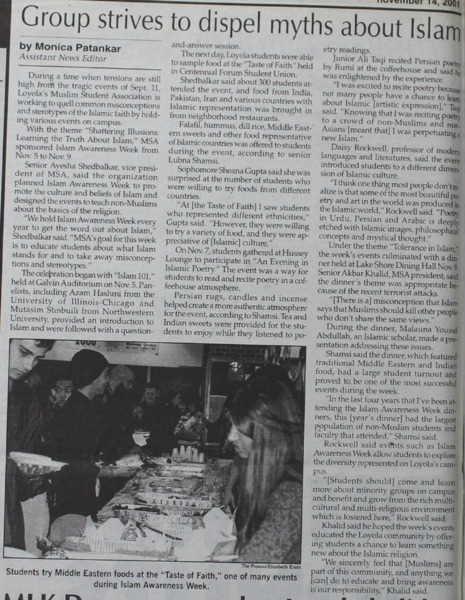
To quell misconceptions and stereotypes of the Islamic faith, Loyola's Muslim Student Association held events under their pre-existing annual Islamic Awareness Week with that focus in mind, theming the week "Tolerance in Islam". One such event was "Taste of Faith". Students could sample food from various countries with Islamic representation that had been brought in from neighborhood restaurants.
-

One repercussion of the 9/11 attacks was increased focus on international students. Proposed legislation to speed up the implementation of a system to monitor international students alarmed the Loyolan community, with faculty concerned that it would restrict students' freedoms.
-
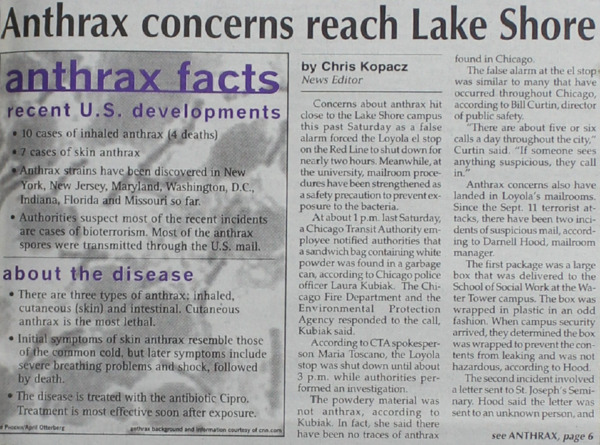
Concerns about anthrax hit close to Loyola's Lake Shore campus as a sandwich bag with white powder was found in a garbage can at the Loyola el stop, causing the stop to shut down for nearly two hours. This turned out to be a false alarm. Loyola's mailrooms, which saw two incidents of suspicious mail, also took measures to guard against potential anthrax threats.
-
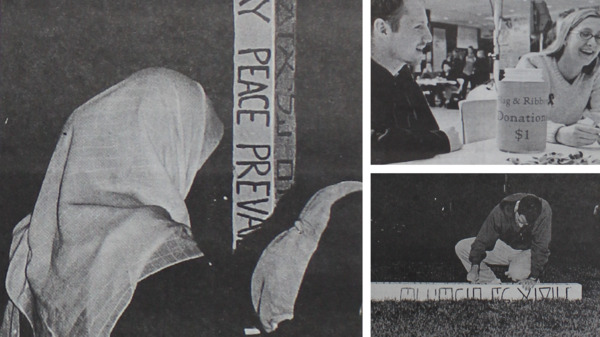
Collage of programs on the Day of Prayer and Remembrance (all original captions):
(left) Students hold a moment of silence in front of the peace pole on Halas Field as part of an Interfaith Peace Vigil. The vigil, part of Loyola’s Day of Remembrance, brought together people of many faiths to remember the victims of the Sept. 11 terrorist attacks.
(top right) Sophomore Joe Boomer (left) and freshman Carrie Mason (right) represent the College Democrats as they sell ribbons in Centennial Forum Student Union Tuesday as a fundraiser for the American Red Cross. The fundraiser was part of Loyola’s Day of Remembrance. The red, white, and blue ribbons were the first to sell out.
(bottom right) Graduate student Brian Christopher, S.J., works to create the peace pole. Christopher inscribes the English version of “May Peace Prevail” on the pole. The slogan was also written in Arabic, Hebrew and Hindi.
*This collage was compiled from various sources. Please see "source" for more information.
-

This article describes the Interfaith Peace Vigil held in the wake of 9/11 for community members and students to come together and pray for peace. It was organized by the civil justice organization, Voices in the Wilderness, which aimed at ending U.S. economic sanctions in place against Iraq for the past 11 years. Representatives from the Buddhist, Christian, Hare Krishna, Hindu, Islamic, Jewish, and Sikh religious communities led prayers during the vigil.
-

Various programs to help students and community members process the events of 9/11 took place on Loyola’s Day of Prayer and Remembrance. Student affairs and a dozen student organizations held a fundraiser and memorial for 9/11 victims, with all money raised donated to the American Red Cross Disaster Relief Fund. Students expressed that involvement in the fundraiser and memorial help them gain some sense of closure over the horrific affairs of 9/11. Apart from the memorial and fundraiser, other programs held included four masses in memory of the victims, a Bake Sale for Peace, and an interfaith peace vigil open to community members.

























